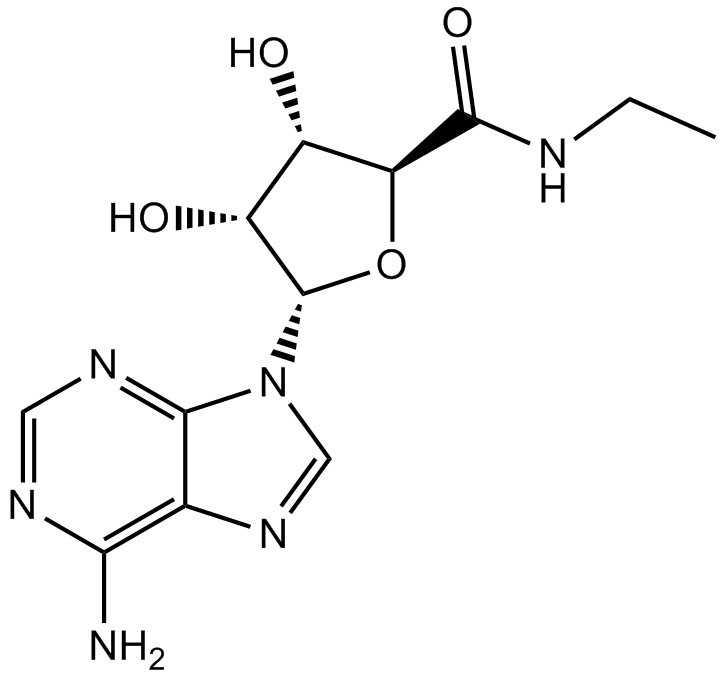NECA
NECA is a non-selective agnonist of adenosine receptor with the concentration of 10 μM [1].
Adenosine is an important endogenous signaling molecule and plays a pivotal role in regulating a wide range of physiological functions, such as immune system response and inflammation, via cooperated with its receptor. It has been shown that adenosine receptor agonists can be either anti-inflammatory or proinflammatory, and the dual role of the adenosine receptor agonists causing these opposing effects should provide a better guide for therapeutic intervention used for different diseases in clinic [2].
When tested with primary murine microglia cells, NECA treatment significantly inhibited the productions of CXCL10 and TNF-αinduced by LPS [1, 3].
In CD73(-/-) mice model infected with T. gondii cysts, administration of NECA protected CD73(-/-) mice against T. gondii-induced immunopathology via agonist adenosine receptor, which suggested that CD73-generated adenosine was critical for immune regulation during T.gondii infection [1]. In a mouse model with human uveitis, injection of NECA at an early stage after immunization with peptides 1-20 inhibited effect on both Th1 and Th17 responses [1, 4]. When tested with adult male Wistar rats of amygdala-kindled seizures, intravenous infusion of NECA after administration of PHT increased the PHT level in brain compared with control group by antognisting adenosine receptor thus strengthened the anticonvulsant properties of PHT against amygdala kindled seizures [5].
References:
[1]. Mahamed, D.A., L.E. Toussaint, and M.S. Bynoe, CD73-Generated Adenosine Is Critical for Immune Regulation during Toxoplasma gondii Infection. Infect Immun, 2015. 83(2): p. 721-9.
[2]. Solomou, S. and M. Korbonits, The role of ghrelin in weight-regulation disorders: Implications in clinical practice. Hormones (Athens), 2014. 13(4): p. 458-475.
[3]. Newell, E.A., et al., 2',3'-cAMP, 3'-AMP, 2'-AMP and adenosine inhibit TNF-alpha and CXCL10 production from activated primary murine microglia via A2A receptors. Brain Res, 2015. 1594: p. 27-35.
[4]. Liang, D., et al., Anti-inflammatory or proinflammatory effect of an adenosine receptor agonist on the Th17 autoimmune response is inflammatory environment-dependent. J Immunol, 2014. 193(11): p. 5498-505.
[5]. Sun, Z., et al., Activation of Adenosine Receptor Potentiates the Anticonvulsant Effect of Phenytoin Against Amygdala Kindled Seizures. CNS Neurol Disord Drug Targets, 2014.
| Physical Appearance | A solid |
| Storage | Store at -20°C |
| M.Wt | 308.3 |
| Cas No. | 35920-39-9 |
| Formula | C12H16N6O4 |
| Solubility | insoluble in H2O; ≥15.35 mg/mL in DMSO; ≥2.61 mg/mL in EtOH with gentle warming and ultrasonic |
| Chemical Name | (2S,3S,4R,5S)-5-(6-amino-9H-purin-9-yl)-N-ethyl-3,4-dihydroxytetrahydrofuran-2-carboxamide |
| SDF | Download SDF |
| Canonical SMILES | CCNC([C@H]([C@H]([C@H]1O)O)O[C@@H]1[n]1c2ncnc(N)c2nc1)=O |
| Shipping Condition | Small Molecules with Blue Ice, Modified Nucleotides with Dry Ice. |
| General tips | We do not recommend long-term storage for the solution, please use it up soon. |
Quality Control & MSDS
- View current batch:
Chemical structure









